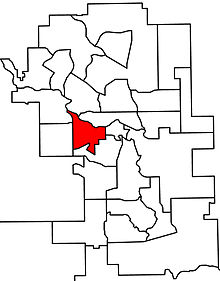Calgary Currie
|
|
|||
|---|---|---|---|

2010 boundaries
|
|||
| Provincial electoral district | |||
| Legislature | Legislative Assembly of Alberta | ||
| MLA |
New Democratic |
||
| District created | 1971 | ||
| First contested | 1971 | ||
| Last contested | 2015 | ||
Calgary-Currie is a provincial electoral district in Calgary, Alberta, Canada. It was created in 1971 and is mandated to return a single member to the Legislative Assembly of Alberta.
The electoral district was created in the 1971 boundary redistribution from parts of Calgary Glenmore and Calgary West.
The 2010 boundary redistribution saw the riding significantly changed. The Electoral Boundary Commission originally tried to abolish the riding but several complaints were submitted to the Commission. Instead the riding was completely redrawn with the north boundary pushed up to the Bow River from 17 Avenue SW into land that was part of Calgary-Bow and Calgary-Buffalo. The east boundary which had gone as far as 1 Street SE was moved west to 14 Street SW losing land to Buffalo and Calgary-Elbow. The south boundary was significantly revised with Elbow causing the riding to gain and lose land with that constituency in a few different places and finally the west boundary was straightened out to run along Sarcee Trail causing the riding to gain land from Calgary-West.
The Calgary-Currie electoral district was created in the boundary redistribution of 1971. The electoral district was named after the former Currie Army Barracks which used to exist in Southwest Calgary. The district replaced large portions of Calgary West and Calgary Glenmore.
The first general election in 1971 saw Progressive Conservative candidate Fred Peacock win a tight race over incumbent Social Credit member Frederick Colborne who had previously represented Calgary Centre. His old electoral district was abolished and he decided to run in Currie instead of Calgary-Buffalo.
During his first term Peacock served as a cabinet minister in the Lougheed government. He was re-elected for a second term in 1975 before he retired from provincial politics in 1979.
...
Wikipedia
